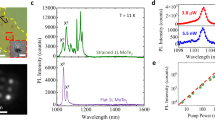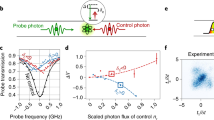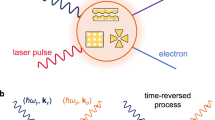Abstract
The development of high-quality solid-state photon sources is essential to nano-optics, quantum photonics and related fields. A key objective of this research area is to develop tunable photon sources that not only enhance the performance but also offer dynamic functionalities. However, the realization of compact and robust photon sources with precise and wide-range tunability remains a long-standing challenge. Moreover, the lack of an effective approach to integrate nanoscale photon sources with dynamic systems has hindered tunability beyond mere spectral adjustments, such as simultaneous polarization control. Here we propose a platform based on quantum-emitter-embedded metasurfaces (QEMS) integrated with a micro-electromechanical system (MEMS)-positioned microcavity, enabling on-chip multidegree control of solid-state photon sources. Using MEMS–QEMS, we show that typically broadband room-temperature emission from nanodiamonds containing nitrogen-vacancy centres can be narrowed to 3.7 nm and dynamically tuned with ångström resolution. Furthermore, we design a wavelength–polarization-multiplexed QEMS and demonstrate polarization-resolved control of the MEMS–QEMS emission in a wide wavelength range (650–700 nm) along with polarization switching at submillisecond timescales. We believe that the proposed MEMS–QEMS platform can be adapted for most existing quantum emitters, significantly expanding their room-temperature capabilities and thereby enhancing their potential for advanced photonic applications.
This is a preview of subscription content, access via your institution
Access options
Access Nature and 54 other Nature Portfolio journals
Get Nature+, our best-value online-access subscription
27,99 € / 30 days
cancel any time
Subscribe to this journal
Receive 12 print issues and online access
209,00 € per year
only 17,42 € per issue
Buy this article
- Purchase on SpringerLink
- Instant access to full article PDF
Prices may be subject to local taxes which are calculated during checkout




Similar content being viewed by others
Data availability
All data that support the findings of the study are provided in the article and its extended data and Supplementary Information. Data are also available from the corresponding authors upon reasonable request.
References
Aharonovich, I., Englund, D. & Toth, M. Solid-state single-photon emitters. Nat. Photonics 10, 631–641 (2016).
Li, Z. et al. Atomic optical antennas in solids. Nat. Photonics 18, 1113–1120 (2024).
Wang, J., Sciarrino, F., Laing, A. & Thompson, M. G. Integrated photonic quantum technologies. Nat. Photonics 14, 273–284 (2020).
Sun, S., Kim, H., Luo, Z., Solomon, G. S. & Waks, E. A single-photon switch and transistor enabled by a solid-state quantum memory. Science 361, 57–60 (2018).
Utzat, H. et al. Coherent single-photon emission from colloidal lead halide perovskite quantum dots. Science 363, 1068–1072 (2019).
Jelezko, F. & Wrachtrup, J. Single defect centres in diamond: a review. Phys. Status Solidi A 203, 3207–3225 (2006).
Ates, S. et al. Non-resonant dot–cavity coupling and its potential for resonant single-quantum-dot spectroscopy. Nat. Photonics 3, 724–728 (2009).
Liu, S. et al. Super-resolved snapshot hyperspectral imaging of solid-state quantum emitters for high-throughput integrated quantum technologies. Nat. Photonics 18, 967–974 (2024).
Ma, J. et al. Engineering quantum light sources with flat optics. Adv. Mater. 36, 2313589 (2024).
Kan, Y. & Bozhevolnyi, S. I. Advances in metaphotonics empowered single photon emission. Adv. Opt. Mater. 11, 2202759 (2023).
Koenderink, A. F. Single-photon nanoantennas. ACS Photonics 4, 710–722 (2017).
Chen, B. et al. Bright solid-state sources for single photons with orbital angular momentum. Nat. Nanotechnol. 16, 302–307 (2021).
Javadi, A. et al. Spin–photon interface and spin-controlled photon switching in a nanobeam waveguide. Nat. Nanotechnol. 13, 398–403 (2018).
Akselrod, G. M. et al. Probing the mechanisms of large Purcell enhancement in plasmonic nanoantennas. Nat. Photonics 8, 835–840 (2014).
Benz, F. et al. Single-molecule optomechanics in “picocavities”. Science 354, 726–729 (2016).
Bogdanov, S. I. et al. Ultrabright room-temperature sub-nanosecond emission from single nitrogen-vacancy centers coupled to nanopatch antennas. Nano Lett. 18, 4837–4844 (2018).
Kan, Y. et al. Metasurface‐enabled generation of circularly polarized single photons. Adv. Mater. 32, 1907832 (2020).
Liu, X. et al. On-chip generation of single-photon circularly polarized single-mode vortex beams. Sci. Adv. 9, eadh0725 (2023).
Komisar, D., Kumar, S., Kan, Y., Wu, C. & Bozhevolnyi, S. I. Generation of radially polarized single photons with plasmonic bullseye antennas. ACS Photonics 8, 2190–2196 (2021).
Liu, X. et al. Ultracompact single‐photon sources of linearly polarized vortex beams. Adv. Mater. 36, 2304495 (2024).
Liu, X. et al. Off-normal polarized single-photon emission with anisotropic holography metasurfaces. Nano Lett. 24, 13867–13873 (2024).
Ha, S. T. et al. Optoelectronic metadevices. Science 386, eadm7442 (2024).
Forbes, A., De Oliveira, M. & Dennis, M. R. Structured light. Nat. Photonics 15, 253–262 (2021).
Nape, I., Sephton, B., Ornelas, P., Moodley, C. & Forbes, A. Quantum structured light in high dimensions. APL Photon. 8, 051101 (2023).
Nowak, A. K. et al. Deterministic and electrically tunable bright single-photon source. Nat. Commun. 5, 3240 (2014).
Larocque, H. et al. Tunable quantum emitters on large-scale foundry silicon photonics. Nat. Commun. 15, 5781 (2024).
Albrecht, R., Bommer, A., Deutsch, C., Reichel, J. & Becher, C. Coupling of a single nitrogen-vacancy center in diamond to a fiber-based microcavity. Phys. Rev. Lett. 110, 243602 (2013).
Casabone, B. et al. Dynamic control of Purcell enhanced emission of erbium ions in nanoparticles. Nat. Commun. 12, 3570 (2021).
Xia, K. et al. Tunable microcavities coupled to rare-earth quantum emitters. Optica 9, 445–450 (2022).
Yang, J. et al. Tunable quantum dots in monolithic Fabry–Perot microcavities for high-performance single-photon sources. Light Sci. Appl. 13, 33 (2024).
Tomm, N. et al. A bright and fast source of coherent single photons. Nat. Nanotechnol. 16, 399–403 (2021).
Ding, X. et al. High-efficiency single-photon source above the loss-tolerant threshold for efficient linear optical quantum computing. Nat. Photonics 19, 387–391 (2025).
Meng, C. et al. Dynamic piezoelectric MEMS-based optical metasurfaces. Sci. Adv. 7, eabg5639 (2021).
Meng, C., Thrane, P. C., Ding, F. & Bozhevolnyi, S. I. Full-range birefringence control with piezoelectric MEMS-based metasurfaces. Nat. Commun. 13, 2071 (2022).
Ding, F., Meng, C. & Bozhevolnyi, S. I. Electrically tunable optical metasurfaces. Photonics Insights 3, R07–R07 (2024).
Andersen, S. K. H. et al. Hybrid plasmonic Bullseye antennas for efficient photon collection. ACS Photonics 5, 692–698 (2018).
Bakke, T. et al. A novel ultra-planar, long-stroke and low-voltage piezoelectric micromirror. J. Micromech. Microeng. 20, 064010 (2010).
Kan, Y. et al. High-dimensional spin-orbital single-photon sources. Sci. Adv. 10, eadq6298 (2024).
Tang, H. et al. On-chip multi-degree-of-freedom control of two-dimensional materials. Nature 632, 1038–1044 (2024).
Dahl-Hansen, R., Gjessing, J., Mardilovich, P., Fragkiadakis, C. & Thorstensen, J. Reliable Pb(Zr, Ti)O3-based thin film piezoelectric micromirrors for space-applications. Appl. Phys. Lett. 121, 132901 (2022).
Kan, Y., Liu, X., Kumar, S. & Bozhevolnyi, S. I. Multichannel quantum emission with on-chip emitter-coupled holographic metasurfaces. ACS Nano 17, 20308–20314 (2023).
Chen, O. et al. Compact high-quality CdSe–CdS core–shell nanocrystals with narrow emission linewidths and suppressed blinking. Nat. Mater. 12, 445–451 (2013).
Iwasaki, T. et al. Tin-vacancy quantum emitters in diamond. Phys. Rev. Lett. 119, 253601 (2017).
Jantzen, U. et al. Nanodiamonds carrying silicon-vacancy quantum emitters with almost lifetime-limited linewidths. New J. Phys. 18, 073036 (2016).
Asbahi, M. et al. Large area directed self-assembly of sub-10 nm particles with single particle positioning resolution. Nano Lett. 15, 6066–6070 (2015).
Pambudi, M. T. et al. Deterministic positioning of few aqueous colloidal quantum dots. Nanoscale 16, 18339–18347 (2024).
Meng, C., Thrane, P. C., Wang, C., Ding, F. & Bozhevolnyi, S. I. MEMS-tunable topological bilayer metasurfaces for reconfigurable dual-state phase control. Optica 11, 1556–1566 (2024).
Bartholomew, J. G., De Oliveira Lima, K., Ferrier, A. & Goldner, P. Optical line width broadening mechanisms at the 10 kHz level in Eu3+: Y2O3 nanoparticles. Nano Lett. 17, 778–787 (2017).
Erhard, M., Krenn, M. & Zeilinger, A. Advances in high-dimensional quantum entanglement. Nat. Rev. Phys. 2, 365–381 (2020).
Lukin, D. M. et al. Spectrally reconfigurable quantum emitters enabled by optimized fast modulation. npj Quantum Inf. 6, 80 (2020).
Pirandola, S. et al. Advances in quantum cryptography. Adv. Opt. Photonics 12, 1012–1236 (2020).
Acknowledgements
We acknowledge T. Yezekyan, O. Takayama and V. Zenin for assistance with the experiment. We also acknowledge the support from European Union’s Horizon Europe research and innovation programme under the Marie Skłodowska-Curie Action grant 101064471 (Y.K.), Research Council of Norway grant 323322 (P.C.V.T.), Villum Fonden 50343 (C.M.) and Villum Kann Rasmussen Foundation (Award in Technical and Natural Sciences 2019) (S.I.B.).
Author information
Authors and Affiliations
Contributions
Y.K. and S.I.B. conceived the idea. Y.K. performed the theoretical modelling. Y.K., P.C.V.T., X.L. and R.M. fabricated the samples. Y.K. and X.L. with assistance from S.K. and C.M. performed the experimental measurements. Y.K., S.K., X.L., P.C.V.T., C.M. and S.I.B. analysed the data. S.I.B. and Y.K. supervised the project. Y.K. wrote the paper with contributions from all authors.
Corresponding authors
Ethics declarations
Competing interests
The authors declare no competing interests.
Peer review
Peer review information
Nature Photonics thanks Na Liu and the other, anonymous, reviewer(s) for their contribution to the peer review of this work.
Additional information
Publisher’s note Springer Nature remains neutral with regard to jurisdictional claims in published maps and institutional affiliations.
Extended data
Extended Data Fig. 1 Fabrication process of MEMS-QEMS device.
a Deposition of a 150 nm Ag layer followed by a 20 nm SiO2 layer on a MEMS chip from 150 mm SOI wafer that are bonded to a support wafer. b Fabrication of the alignment gold markers through a combined process, including EBL, gold deposition, and lift-off. c Spin coating the solution of NVs-NDs onto the surface. d Locating the positions of NVs-NDs relative to the prefabricated alignment markers in a 100 × 100 μm2 area, using the dark-field microscope image and a developed precise alignment procedure. Subsequently, QEMS (that is, Bullseyes and multiplexed metasurfaces) are fabricated around NVs-NDs by EBL. e The support chip is removed by dissolving the waferbond with waferbond remover. f The DBR is fabricated by magnetron sputtering. g The DBR is mounted onto the MEMS mirror using Loctite 401. h The device is assembled with a PCB and wirebonded.
Extended Data Fig. 2 Experimental setup for characterizing MEMS-QEMS.
a Sample stage. A piezo-stage allows for locating NVs-NDs in MEMS-QEMS. Actuation voltages applied on MEMS-QEMS are controlled in real time via a computer-connected controller. b Excitation module. A 532 nm incident laser is used for exciting NV-NDs. Pulse laser is used for lifetime measurements. c Illumination module. Enabling finding the fabricated QEMS inside the microcavity. d Characterization module for measuring emission pattern, response time, stability, and decay-rate. Fluorescence photon rates are recorded using avalanche photo diodes (APDs), with excitation lasers filtered by a set of dichroic mirrors (DM) and a long pass filter (LPF). e Characterization module for acquiring spectra using the spectrometers (Ultra 888 USB3 –BV, Andor; QE pro, Ocean Optics). CW: continuous wave, RP: radial polarization converter, PBS: polarized beam splitter, PH: pinhole, DM: dichroic mirror, LP: linear polarizer, LPF: 550 nm long pass filter, BPF: 650 nm ± 5 nm, 670 nm ± 5 nm, and 700 nm ± 5 nm. FM: flip mirror, GM: galvanometric mirror. APD: avalanche photodiode.
Extended Data Fig. 3 The relationship between emission peak wavelength and voltage of channel C7 (under Vc) with a fine step of 50 mV.
The results show a quasi-linear relationship between the emission peak wavelength and the actuation voltage, featuring an average wavelength shift of 0.8 Å per 50 mV.
Extended Data Fig. 4 Dynamical tunable polarized solid-state photon sources under voltage Vc.
a Measured photon emission spectra with LPx and LPy polarizations under actuation voltage Vc. The grey shaded area indicates the normalized spectrum of the QEMS before integration into the MEMS-DBR microcavity. b Measured far- field emission patterns at λ = 650 nm, λ = 670 nm, and λ = 700 nm with different polarizations. The white circles indicate NA = 0.5.
Extended Data Fig. 5 Realization of simultaneous dual- emission peaks at 650 nm and 700 nm.
a Measured spectrum of photon emission exhibiting dual-emission peaks at 650 nm and 700 nm, by adjusting the gap distance to around 3.689 µm. The grey shaded area indicates the normalized spectrum of the QEMS before integration into the MEMS-DBR microcavity. b Measured far-field emission patterns at λ = 650 nm and λ = 700 nm with different polarizations. The white circles indicate NA = 0.5.
Supplementary information
Supplementary Information
Supplementary Figs. 1–7 and Tables 1–3.
Rights and permissions
Springer Nature or its licensor (e.g. a society or other partner) holds exclusive rights to this article under a publishing agreement with the author(s) or other rightsholder(s); author self-archiving of the accepted manuscript version of this article is solely governed by the terms of such publishing agreement and applicable law.
About this article
Cite this article
Kan, Y., Thrane, P.C.V., Liu, X. et al. Ångström-tunable polarization-resolved solid-state photon sources. Nat. Photon. (2025). https://doi.org/10.1038/s41566-025-01709-x
Received:
Accepted:
Published:
DOI: https://doi.org/10.1038/s41566-025-01709-x



